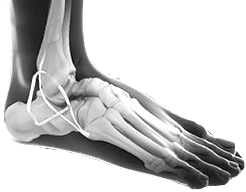Ankle Ligament Reconstruction
What is Ankle Ligament Reconstruction?
Ankle Ligament Reconstruction is surgery is performed to re-establish a ligaments bone to bone connection.
Most commonly Lateral Ankle Ligament reconstruction is a surgery to tighten and firm up one or more ankle ligaments on the outside of your ankle. It’s also known as the Brostrom procedure.
When is Ankle Ligament Reconstruction Indicated?
It is very uncommon to need early surgery after an acute ankle sprain. Even Grade 3 sprains have a 70% chance of good recovery without surgery.
This procedure is usually recommended in the case of Recurrent Ankle Sprains or Instability
Benefits of Ankle Ligament Reconstruction
The surgery is performed to:
- Stop recurrent episodes of rolling the ankle and sprains
- Improve function so you can move and enjoy daily activities
- Return to sport and physical activity
Steps of Ankle Ligament Reconstruction Procedure
The procedure is performed:
- After appropriate diagnostic assessments, pre surgery checks and preparations are complete.
- In hospital and normally take 1 hour
The procedure is normally performed under a general anaesthetic and includes the following steps:
- An arthroscopy is then performed through 2 small (keyhole) incisions at the front of the ankle or over the outside of the ankle where the ligaments have been torn away
- Tendons behind the ankle are inspected routinely and inflamed tissue is removed (tenosynovectomy) or repaired as necessary.
- Joint surfaces are inspected, inflammatory and scar tissue is removed, and any bony spurs (osteophytes) are trimmed away.
- Where Ankle Ligament Reconstructions is required the torn ligaments, muscles, or tendons there are two approaches:
- Anatomic Repair: involves stretching, shortening and tightening the ligament as needed where stitches or other types of sutures are used to reinforced the overlying tissue (modified Bröstrum-Gould repair)
- Non-Anatomic Repair: uses a tendon as a graft to replace the damaged or weakened ligaments with a section of tendon derived from the foot and around the ankle and grafted
- At the end the surgery the incision is closed and the patient is sent to the recovery ward for observation
Preparation for Ankle Ligament Reconstruction Surgery
Once you and your surgeon have decided that surgery is required, preparation is necessary to achieve the best results and a quick and problem free recovery.
- Infections - Treat any tooth, gum, bladder or bowel problems before surgery to reduce the risk of infection
- Smoking - Stop or cut down smoking to reduce your surgery risks and improve your recovery
- Weight - Consider losing weight (if overweight) before surgery
- Medications - refer Medication Information below
- Fast beforehand - Depending on the type of anaesthesia you'll be receiving, your doctor may advise you to refrain from eating and drinking six to twelve hours before the procedure.
- Arrange for a ride - You will not be allowed to drive yourself home after the procedure, so make arrangements for someone to pick you up. If you live alone, arrange for someone to check on you that evening or, ideally, to stay with you for the rest of the day.
Returning Home After Surgery
When you go home you need to take special precautions around the house to make sure it is safe. Your post operative plans should include:
- Mobility or Stability - You may have to accommodate crutches, wheelchair or knee scooter and may need ramps for stairs
- Sleeping - modify your sleeping arrangements (especially if you are sleeping upstairs) for easy access
- Access - ensure you have easy access to food, water, medications and any other essentials
- Showering - You may require rails in your bathroom or a shower chair, and will and a specialised shower bag to keep your foot dry
Assess your home situation to ensure you have adequate home support in the first few weeks following surgery. If you live alone it may be necessary to arrange a package of community care to help during the first few weeks at home.
Ankle Ligament Reconstruction Surgery Process
Some patients with severe or chronic sprains may not be able to return to their prior level of activity.
Ankle Ligament Reconstruction Rehabilitation Program
Risks & Complications Associated with Ankle Ligament Reconstruction
Surgical Follow Ups
How Can I Minimise Post Operative Complications?
- Elevation - Keeping your foot/ankle elevated above your heart when sitting and sleeping will help with pain, swelling and help wound healing
- Blood clots (DVT or PE) - Through early mobilisation, stockings, and medications
- Pain - Keep on top of pain with regular use of pain medications as directed by your surgeon
- Dressings - Keep dressings dry and intact
- Shoewear - Keep your prescribed shoe (heel wedge, moonboot) on as instructed
- Let us know early if you have any questions or worries
What Are the Consequences of Surgery?
Sometimes the potential risks and consequences of your surgical procedure need to be weighed against the benefits of a successful surgical outcome.
These benefits can include:
- Freedom from pain
- Increased movement
- Greater flexibility
- Maintained independence
- Improved outlook
- Longer more enjoyable life








